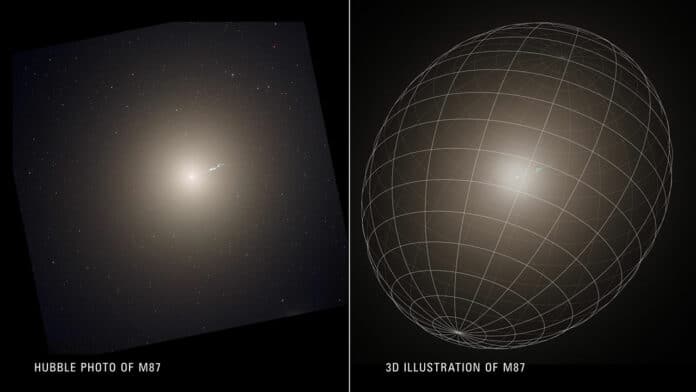The celestial objects seen through a telescope appear flat because they are so distant. Now, for the first time, astronomers have measured the 3D shape of a giant galaxy, M87.
It turns out that this galaxy is “triaxial,” or potato-shaped. The combined power of the ground-based W. M. Keck Observatory in Maunakea, Hawaii, and NASA’s Hubble Space Telescope allowed for the creation of this stereo vision.
Scientists measured the star’s motion- swarming around the galaxy’s supermassive central black hole- to create the 3D plot. They used stellar motion to gain insights into the galaxy’s shape and rotation. It also yielded a new measurement of the black hole’s mass. Tracking the stellar speeds and position allowed researchers to build a three-dimensional view of the galaxy.
The black hole’s mass in the galaxy’s center was precisely estimated by astronomers at the University of California, Berkeley, to be 5.4 billion times the mass of the Sun. Astronomers estimated the mass of the M87 black hole using Hubble data in 1995, which they did by timing the speed of the plasma spinning around the black hole. In 2019, the Event Horizon Telescope, an international network of ground-based telescopes, published the first-ever image of the same black hole. Due to the size of its completely black event horizon, researchers were able to estimate the black hole’s mass to be 6.5 billion solar masses.
Chung-Pei Ma, a UC Berkeley lead investigator, said, “The stereo model of M87 and the more precise mass of the central black hole could help astrophysicists learn the black hole’s spin rate. Now that we know the direction of the net rotation of stars in M87 and have an updated mass of the black hole, we can combine this information with data from the Event Horizon Telescope to constrain the spin.”
“Over ten times the mass of the Milky Way, M87 probably grew from the merger of many other galaxies. That’s likely why M87’s central black hole is so large — it assimilated the central black holes of one or more galaxies it swallowed.”
Using a new precision instrument mounted on the Keck II Telescope, astronomers were able to determine the 3D shape of M87. They focused Keck at 62 nearby galaxies, measuring the stellar spectra over 70,000 light-years. This region spans the core 3,000 light-years, where the supermassive black hole’s gravity predominates. Due to M87’s enormous distance, the telescope cannot discern individual stars, but the spectra can be used to determine the mass of the object they are orbiting.
Ma said, “It’s sort of like looking at a swarm of 100 billion bees. Though we are looking at them from a distance and can’t discern individual bees, we are getting very detailed information about their collective velocities.”
The data was gathered between 2020 and 2022. They also took earlier star brightness measurements of M87 from Hubble and compared them to computer model predictions of how stars move around the center of the triaxial-shaped galaxy.
Credits: ANIMATION: NASA, ESA, Joseph Olmsted (STScI)
3D MODEL: Frank Summers (STScI)
SCIENCE: Chung-Pei Ma (UC Berkeley)
Ma said, “The best fit to this data allowed them to calculate the black hole’s mass. Knowing the 3D shape of the ‘swarming bees’ enabled us to obtain a more robust dynamical measurement of the mass of the central black hole governing the bees’ orbiting velocities.”
Journal Reference:
- Emily R Liepold, Chung-Pei Ma et al. Keck Integral-field Spectroscopy of M87 Reveals an Intrinsically Triaxial Galaxy and a Revised Black Hole Mass. The Astrophysical Journal Letters. DOI 10.3847/2041-8213/acbbcf
